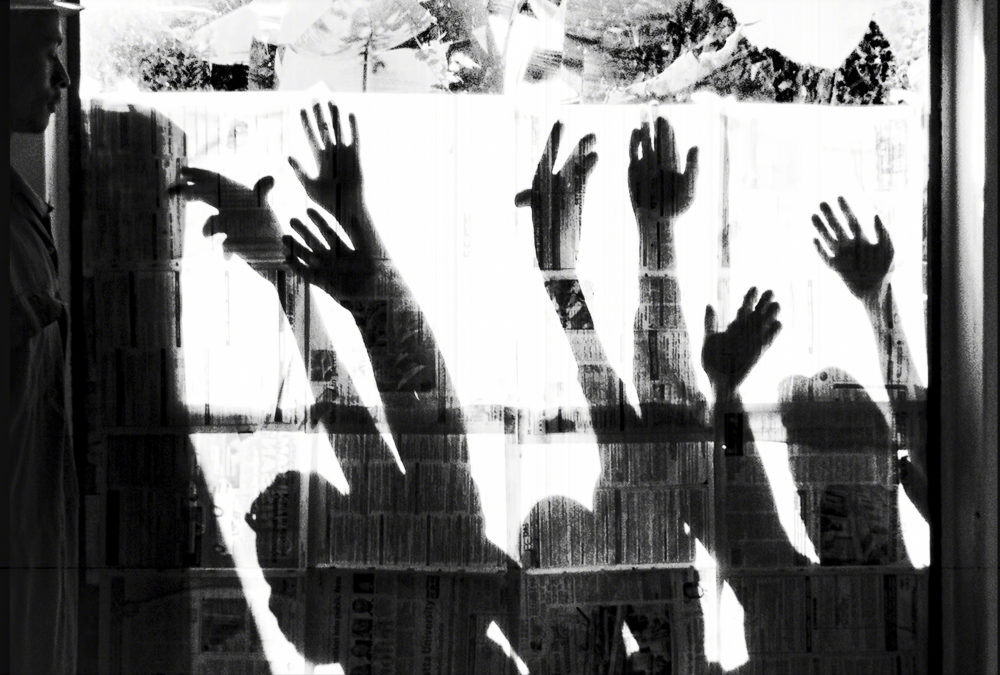In the News: From Santa Muerte to Saint Leonard Cohen
A round-up of recent religion news.

First, we’ve been a bit distracted from our usual reading rounds this month by The Immanent Frame‘s fantastic ongoing series “Is This All There Is” which, this month, included work by lots of Revealer friends, such as:
Liane Carlson‘s “It was no way to die”
At the center of all of these arguments about the religious core to secularism is a belief in a Christian past that can neither be lost nor forgotten. Even when people have abandoned all of the internal and external markers of Christianity, even when they have given up belief and practice, even when they desperately try to distance themselves through polemics from their Christian heritage, Christianity’s influence persists in the faith they accord the sovereign, the arguments they use to bomb foreign countries, the wonder with which they face art. Secularism debates are an argument for history as haunting.
Laura McTighe‘s Many hands make light work
I emphasize this momentum, indeed obligation, to bring Black feminist theory into everyday practice in order to keep in check a certain romanticism. Truth-telling is bone-deep, essential work. It is also survival work. We must never mistake the work undertaken in order to persist for the world-building transformation of living and thriving. Grappling with this obligation to praxis in my own scholarship and activism has forced me to ask two questions: (1) How does one square the impulse to avoid reducing Black life to the quotidian terror that structures the everyday, with the brutal facticity of anti-Black violence and death revealed throughout history? And (2) at what points do attempts to imagine otherwise actually serve to undermine the ever-shifting intersections of intimate, community, and state violence? These questions require new answers every day.
Elayne Oliphant‘s Clothing the emperor in medieval garb
The link between contemporary art and contemporary religiosity I am sketching here is that of permanent crisis. If both religion and art are reduced to visual spectacle and marketplace successes, then where in the immanent frame can we seek out that “fullness” described by Charles Taylor? One response to this experience of permanent crisis has been the rise in what many have described as an intellectualist turn in European Christianity.
Anthony Petro‘s Camp conviction and the politics of religion: Or, that naked public square’s really a drag*
(*Correction: This piece actually appeared in The Immanent Frame’s terrific “American religion, humility, and democracy.” series.)
Camp is about making fun, subverting meaning, mocking authority—not things most modern Americans or scholars of religious studies would align with “religion.” But it also requires deep attachment, even intimacy, with the thing that becomes the object of camp. Navarro’s drag re-signifies Jesus in at least two ways. He reclaims Jesus from Christian conservatives but also resurrects Jesus for queer and feminist activists. In his performance, Jesus becomes a figure to play with as well as one to aspire toward, even to inhabit. Navarro’s Chicano AIDS activist Jesus thus becomes not only another representation of the Son of God, but also a performance that makes Jesus present as a feminist and queer activist.
Anthea Butler‘s Space is all there is
I am sick of America’s racist history. I am sick of America’s racist present. I am sick of one nation under god. I actually do not think god wants much to do with this place, if god exists. I want to flee America’s racist future; I cannot imagine America not being anything but comfortable to white supremacists and well-meaning white liberal racists.
This is not my version of “Is this all there is.”
I want more.
Donovan Schaefer‘s Material mourning in the secular sculpture garden
The dead do not talk to us. Scattered reports of life-after-death communications or visions notwithstanding, our information about a world after life hovers at zero. To posit an afterlife is to believe, to deny is to disbelieve. But the seeming clarity of this crisp religion/secular divide is deceptive exactly because the register of stated belief is unjoined from the register of action, expression, and material culture. When we expand the one-dimensional frame of “what bodies think” to a more expansive attention to “what bodies do,” the difference all but vanishes. Secular and non-secular people—people announcing beliefs in diametric opposition to each other—treat the dead in strikingly similar ways.
Ruth Braunstein‘s Political myopia and prophetic vision, and many others.
The men and women of Westeros learn the hard way that not all prophets, or at least not all visions, are to be trusted (RIP Shireen Baratheon). As in real life, there is a fine line between prophetic vision and delusion. But, also as in real life, it is difficult to know which is which, especially without the benefit of hindsight or dramatic irony. When prophetic visions advance the interests of those in power, they are often embraced along with their carriers (recall that the Red Priestess and her Lord of Light originally brought flattering news to Stannis Baratheon . . .).
Read the whole series!
Elsewhere, other friends had some important things to say, including Ed Simon eulogizing Our Last “Genius” Stephen Hawking is Gone… Cause for worry or inspiration over at Religion Dispatches
Genius, like all concepts, has a history—and a particularly recent one at that. If antiquity had her seers, her seekers, and her saints, then modernity rather enshrined the myth of the solitary and brilliant mind, who, through his very genius, could illuminate the contours of creation. As Denis Diderot wrote in his voluminous Encyclopedia, “the genius seems to change the very nature of things; his character envelops whatever it touches; he casts into the future his piercing lights; he leaps ahead of his century, and it is powerless to follow him.”
Adam Kotsko giving a great talk On Trump and Neoliberalism
And you can listen to Benjamin Aldes Wurgaft‘s talk Cultured Meat and the Three Futures for Flesh given at the Wolf Humanities Center. (For more from Wurgaft on lab-grown meat and religion, have a look back at his Revealer piece, But Will The Lab-Grown Meat Be Kosher?)
As a bonus, in the recording you’ll hear Wurgaft introduced by none-other than our favorite Twitterer, Emily Wilson.
https://soundcloud.com/wolf-humanities-center/benjamin-wurgaft-cultured-meat-and-the-three-futures-of-flesh
Back to reading, do check out Peter Manseau on The surprising religious backstory of ‘Black Panther’s’ Wakanda in The Washington Post
Lee and Kirby likely did not look to 19th-century newspapers or ethnographic reports to name their own abode of intrepid and courageous warriors. But by the time they introduced Black Panther and his kingdom, Wakanda lingered in parts of the United States as a haunting remnant of displaced languages and beliefs. As Wakanda, Wakonda, and Waconda, it had become a commonplace name throughout the Midwest, and, most intriguingly when considering its afterlife as the distant realm of superheroes, in the mid-20th century it was a popular name for summer camps in the mid-20th century, those ephemeral nations of experience that seemed to appear only when children fled the familiar to join a magical land.
Suzanne Schneider introducing her new book Mandatory Separation: Religion, Education, and Mass Politics in Palestine over at Jadaliyya
I would like to think that the questions I raise in this book—informed by a close reading of sources ranging from archival documents to textbooks and short stories—are still quite fundamental: Is religion about faith or practice, individual salvation or communal responsibility? How is the religious sphere demarcated vis-à-vis material or social life? What are the political uses of religion, and what role do schools play therein? How do modern educational methods and pedagogy not just convey, but also actually shape, what we understand religion to be? Given this set of concerns, Mandatory Separation is not an institutional history of a particular type of schooling but rather a conceptually-driven study that tries to attend to the points of continuity and rupture among Palestine’s disparate, and increasingly antagonistic, communities.
And Ann Neumann on The Narco Saint: How a Mexican folk idol got conscripted into the drug wars for The Baffler
Beloved by millions for her granting of daily needs and requests, Santa Muerte, the saint on altars of the poor, endangered, disenfranchised, and heartbroken, represents a principle of compassion and order within a socioeconomic hierarchy notably short on both. But she means something quite different to her adherents than she does to drug-warring governments. To police and military officials seeking to eradicate the violent scourge of black money, kidnappings, and violence that straddles the border, she is little short of the devil incarnate.
Meanwhile, we’d very much like to be friends with religion professor Kate Bowler was interviewed about her new book, Everything Happens for a Reason: And Other Lies I’ve Loved, on Fresh Air, A Stage-4 Cancer Patient Shares The Pain And Clarity of Living ‘Scan-To-Scan’ and also wrote I’m a scholar of the “prosperity gospel.” It took cancer to show me I was in its grip. for Vox
I don’t think I knew enough about longing 10 years ago when I started investigating the prosperity gospel. I had just bought a little house with the man I love. I filled it with books, Ikea furniture, and a soft dog with legs as stout as soup cans. I was steeped in the lore of eternal youth. My life was something I could mold, or at least correct with a surge of determination. It was the same unlimited confidence that the prosperity gospel calls “victory.” Nothing was broken yet that could not be fixed.
And from UC Berkeley, we were very sad to learn of the death of esteemed professor Saba Mahmood.
Mahmood made path-breaking contributions to contemporary debates on secularism, opening up new ways of understanding religion in public life and contesting received assumptions about both religion and the secular. Against an increasingly shrill scholarship denouncing Muslim societies, she brought a nuanced and educated understanding of Islam into discussions of feminist theory, ethics and politics. Her publications and presentations have reverberated throughout the humanities and social sciences, profoundly shaping the scholarship of a new generation of scholars as they develop a thoughtful, knowledgeable, and critical approach to religion in modernity. As a scholar and teacher, she embodied and followed strong moral and political principles, offered keen analyses of colonial and capitalist power in her account of secularism’s modernity, and formulated new ways of understanding the subject of feminism, relational subjectivity, religious freedom, religious injury, the rights of religious minorities, and comparative legal analysis of religious and secular family law and sexual regulations.
We were also very glad to see Roberta Mazza talking about The Illegal Papyrus Trade and What Scholars Can Do to Stop It for Hyperallergic
We academics must help protect the objects we study. Some of my colleagues believe that scholarship comes first, or say that texts have no guilt, so we should be faithful to them. They publish what emerges from the market. I disagree. To publish papyri with suspicious — if not illegal — provenance is unethical. It lends a new identity to those artefacts and feeds the illicit market.
And are thinking of planning a pilgrimage north thanks to Dan Bilefsky recent piece, Is Leonard Cohen the New Secular Saint of Montreal? for The New York Times
In the pantheon of Montreal cultural figures, the soulful, self-effacing singer occupies exalted space. But befitting a spiritual man whose art was nourished by Judaism, Catholicism and Buddhism, Cohen attracts a form of devotion here that can border on the messianic.
While we’re on the topic of music, John Eligon wrote a very interesting post About That Song You’ve Heard, Kumbaya for The New York Times
Thanks to research and lobbying by residents of a coastal community descended from slaves, the origins and meaning of “Kumbaya” have been recognized in Congress, raising hopes that a fading culture might get a boost. The song may be sung more often than usual this month, especially in the part of Georgia where its soulful lyrics are said to have originated almost a century ago.
More in the mood for a movie? Samuel Ashworth wrote about how In the Dark All Katz are Grey: Notes on Jewish Nostalgia for Hazlitt
And this, finally, is why we look backwards. Because it’s not the meaning of the words that matters anymore (if you actually look at what Kaddish means, it has no reference to death or mourning; it’s just more kvelling about how swell God is), it’s the act of incantation. To sing a song whose words you do not understand, in a language you do not speak, and all the same to trust, to know in your very bones, that in singing this song you are bringing grace—that is faith. That is faith.
And we were really excited to learn more about Shterna Goldbloom‘s project Sitra Achra: the Ones Who Don’t Follow in this conversation with Diana Clarke at In Geveb
The best part of making work is having it resonate with people, and I love that you picked up on the intersection of losing something at the same time as purity, or kashrus is gained. Hair is a really important theme for me and also has a lot of significance in Jewish life and Jewish history: women cover their hair, boys cut their hair at the age of three, the Nazir can’t cut his hair and Shimshon loses his power when his hair is cut. A lot of different themes came together for me when I was conceptualizing this image. I was, in the first place, thinking about the roles of men and women in traditional Jewish life. We know of course that men have always created Halacha, or Jewish law, and this affects women’s lives and bodies in extraordinarily intimate ways. But I also know and have known so many women who feel purified, or “kosher” through these laws, and I wanted to think about female agency in interactions where men are making decisions about the female body. The meeting point of violence and redemption is so crucial for me. I think that hair is a really personal thing, and that even just a small change in someone’s hair style or hair length can change the way a person feels or is perceived and gendered.
Lastly, if you’ll allow me to shift out of our standard “Revealer We” and into the first person for a moment, I can’t pass up this chance to share a wonderful story my uncle, David Rubin, recently told about Befriending a Hockey Pro on the Neighborhood Ice on Bill Littlefield‘s Only A Game.
“He asked me my name. I told him,” David says. “He then asked me — he said, ‘Are you Jewish?’ And I said, ‘Yes.’ And he said, ‘Me, too. I’m Jewish, too.’ Just about at that point, handed me his hockey stick and his practice puck. And he said, ‘You take these.’ “
Thanks for listening and reading along with us (back to “we”) with us again this month. We’ll see you again soon!
***
You can find previous “In the News” round-ups here.




